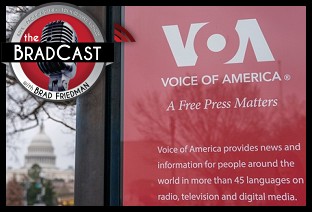 As presented to DNC Chairman Howard Dean this morning, the DNC Voting Rights Institute has finally released it's long-awaited report entitled "Democracy at Risk: The 2004 Election in Ohio".
As presented to DNC Chairman Howard Dean this morning, the DNC Voting Rights Institute has finally released it's long-awaited report entitled "Democracy at Risk: The 2004 Election in Ohio".
We're currently reviewing the report, which is available for download in full or by sections at the DNC website.
 Donna Brazile, the chair of the Voting Rights Institute introduced the report at a press conference this morning as reported by The BRAD BLOG late last night. In her opening statements she said that the report "was five months in the making and represents an exhaustive review of public documents."
Donna Brazile, the chair of the Voting Rights Institute introduced the report at a press conference this morning as reported by The BRAD BLOG late last night. In her opening statements she said that the report "was five months in the making and represents an exhaustive review of public documents."
We will make her full opening statement available here shortly. Here are some of the highlights from that statement [emphasis added]...
Our study addresses legitimate questions and concerns raised in Ohio, including questions about voting machines --- How effective were they?
Why were there enough machines in some counties and not in others? Why were there so many more provisional ballots cast in Ohio than in other states of comparable size?
2.8% of all ballots cast in Ohio were provisional ballots, as contrasted with only 0.9% in PA and 0.3% in FLA.
Why were people standing in line for hours and why weren't they showing up on the rolls after so many new voters registered? Why did young people have so many hassles voting?
...
Our report concludes that more than one-quarter of Ohio voters had problems at the polls. Far more troubling, twice as many African American voters reported problems at the polls than did white voters.
...
African American voters reported waiting an average of 52 minutes before voting while white voters overall reported waiting 18 minutes.
...
African American voters were far more likely to have their registration status challenged and to report experiencing intimidation at the polls than other voters. 16% of African Americans reported experiencing intimidation at the polls as opposed to 5% of whites.
...
Counties using touchscreen machines had far more problems than voters in other counties.
...
Nearly one-quarter of Ohio voters report that their experience in 2004 has made them less confident about the reliability of elections in Ohio. 71% of whites reported being very confident their vote was counted as opposed to 19% of African Americans.
...
Election reform is a bipartisan responsibility and a bipartisan concern. The Democratic Party will continue to work with Members of Congress, state lawmakers, local election officials and community leaders to make sure that all voters maintain confidence in our system of elections.
...
Among the recommendations made in our report, is the request for a commitment on the part of the Democratic Party to monitor election reform in all fifty states and the district of Columbia, including the codification into law of all election practices; the adoption of clear standards for the equitable distribution of voting equipment and the assignment of poll workers; the adoption of uniform standards for voter registration and the monitoring of same; the implementation of statewide voter lists; the adoption of uniform standards for the issuance of provisional ballots and enforceable rules for counting provisional ballots; to adopt legislation which limits identification requirements to first time voters at the time they apply for voter registration or the first time they vote, whichever should first occur, and to adopt and enforce procedures to guarantee that identification requirements are not abused as a voter suppression tactic; to encourage the adoption of precinct-tabulated optical scan voting machines; to abstain from using touchscreen voting machines unless or until they are perfected such that they are no longer vulnerable to fraud---and even then, to discontinue the use of touchscreen voting machines that do not have a reliable voter verifiable audit feature; to discontinue the use of punchcard systems; and to require voting equipment vendors to disclose source codes so that they may be examined by third parties and ensure that voting procedures are transparent at every level of the voting process; to push for legislation requiring that all equipment used by voters to tabulate votes must not be used for any other purpose; to encourage states to adopt "no excuse required" standards for absentee voting; to encourage states to make it easier for college students to vote in the jurisdiction where their school is located; to develop secure and effective voting procedures for registered voters living overseas; to make voter suppression a criminal offense in every jurisdiction; to improve the education of poll workers and to educate voters where, when and how to vote; and to prohibit partisan officials who volunteer to work for a candidate from overseeing or administering that candidate's election.
...DEVELOPING...


 Dems Step Up: Crawford Landslide in WI; Booker Makes History in U.S. Senate: 'BradCast' 4/2/25
Dems Step Up: Crawford Landslide in WI; Booker Makes History in U.S. Senate: 'BradCast' 4/2/25 Judge Dismisses Long-Running Challenge to GA's Unverifiable, Insecure E-Vote System: 'BradCast' 4/1/25
Judge Dismisses Long-Running Challenge to GA's Unverifiable, Insecure E-Vote System: 'BradCast' 4/1/25 'Green News Report' 4/1/25
'Green News Report' 4/1/25
 Bad Court and Election News for Trump is Good News for America: 'BradCast' 3/31/25
Bad Court and Election News for Trump is Good News for America: 'BradCast' 3/31/25 Sunday 'Great Start!' Toons
Sunday 'Great Start!' Toons Vets Push Back at Trump, Musk Plan to Slash Health Care, 80K V.A. Jobs: 'BradCast' 3/27/25
Vets Push Back at Trump, Musk Plan to Slash Health Care, 80K V.A. Jobs: 'BradCast' 3/27/25 'Green News Report' 3/27/25
'Green News Report' 3/27/25 Signal Scandal Worsens for Trump, GOP; Big Dem Election Wins in PA: 'BradCast' 3/26
Signal Scandal Worsens for Trump, GOP; Big Dem Election Wins in PA: 'BradCast' 3/26 'Emptywheel' on Why Trump NatSec Team Should 'Resign in Disgrace' After Signal Chat Debacle: 'BradCast' 3/25/25
'Emptywheel' on Why Trump NatSec Team Should 'Resign in Disgrace' After Signal Chat Debacle: 'BradCast' 3/25/25 'Green News Report' 3/25/25
'Green News Report' 3/25/25 USPS 'Belongs to the People, Not the Billionaires': 'BradCast' 3/24/25
USPS 'Belongs to the People, Not the Billionaires': 'BradCast' 3/24/25 Sunday 'Suddenly Conceivable' Toons
Sunday 'Suddenly Conceivable' Toons 'Green News Report' 3/20/25
'Green News Report' 3/20/25 We're ALL Voice of America Now: 'BradCast' 3/20/25
We're ALL Voice of America Now: 'BradCast' 3/20/25 What Trump's 'Timber Production Expansion' Means (and Costs): 'BradCast' 3/19/25
What Trump's 'Timber Production Expansion' Means (and Costs): 'BradCast' 3/19/25 Courts Largely Holding Against Trump, Musk Lawlessness: 'BradCast' 3/18/25
Courts Largely Holding Against Trump, Musk Lawlessness: 'BradCast' 3/18/25 Chief VOA Reporter on Outlet Falling Silent First Time Since 1942: 'BradCast' 3/17/25
Chief VOA Reporter on Outlet Falling Silent First Time Since 1942: 'BradCast' 3/17/25 Trump EPA Unveils Plans to Endanger, Sicken Americans: 'BradCast' 3/13/25
Trump EPA Unveils Plans to Endanger, Sicken Americans: 'BradCast' 3/13/25 Trump Nixed Enforce-ment Against 100 Corp. Lawbreakers: 'BradCast' 3/12/25
Trump Nixed Enforce-ment Against 100 Corp. Lawbreakers: 'BradCast' 3/12/25 Bad Day for 'Strongmen': 'BradCast' 3/11
Bad Day for 'Strongmen': 'BradCast' 3/11 WI Election Could Flip Supreme Court Control, Musk Jumps In: 'BradCast' 3/10
WI Election Could Flip Supreme Court Control, Musk Jumps In: 'BradCast' 3/10
 VA GOP VOTER REG FRAUDSTER OFF HOOK
VA GOP VOTER REG FRAUDSTER OFF HOOK Criminal GOP Voter Registration Fraud Probe Expanding in VA
Criminal GOP Voter Registration Fraud Probe Expanding in VA DOJ PROBE SOUGHT AFTER VA ARREST
DOJ PROBE SOUGHT AFTER VA ARREST Arrest in VA: GOP Voter Reg Scandal Widens
Arrest in VA: GOP Voter Reg Scandal Widens ALL TOGETHER: ROVE, SPROUL, KOCHS, RNC
ALL TOGETHER: ROVE, SPROUL, KOCHS, RNC LATimes: RNC's 'Fired' Sproul Working for Repubs in 'as Many as 30 States'
LATimes: RNC's 'Fired' Sproul Working for Repubs in 'as Many as 30 States' 'Fired' Sproul Group 'Cloned', Still Working for Republicans in At Least 10 States
'Fired' Sproul Group 'Cloned', Still Working for Republicans in At Least 10 States FINALLY: FOX ON GOP REG FRAUD SCANDAL
FINALLY: FOX ON GOP REG FRAUD SCANDAL COLORADO FOLLOWS FLORIDA WITH GOP CRIMINAL INVESTIGATION
COLORADO FOLLOWS FLORIDA WITH GOP CRIMINAL INVESTIGATION CRIMINAL PROBE LAUNCHED INTO GOP VOTER REGISTRATION FRAUD SCANDAL IN FL
CRIMINAL PROBE LAUNCHED INTO GOP VOTER REGISTRATION FRAUD SCANDAL IN FL Brad Breaks PA Photo ID & GOP Registration Fraud Scandal News on Hartmann TV
Brad Breaks PA Photo ID & GOP Registration Fraud Scandal News on Hartmann TV  CAUGHT ON TAPE: COORDINATED NATIONWIDE GOP VOTER REG SCAM
CAUGHT ON TAPE: COORDINATED NATIONWIDE GOP VOTER REG SCAM CRIMINAL ELECTION FRAUD COMPLAINT FILED AGAINST GOP 'FRAUD' FIRM
CRIMINAL ELECTION FRAUD COMPLAINT FILED AGAINST GOP 'FRAUD' FIRM RICK SCOTT GETS ROLLED IN GOP REGISTRATION FRAUD SCANDAL
RICK SCOTT GETS ROLLED IN GOP REGISTRATION FRAUD SCANDAL VIDEO: Brad Breaks GOP Reg Fraud Scandal on Hartmann TV
VIDEO: Brad Breaks GOP Reg Fraud Scandal on Hartmann TV RNC FIRES NATIONAL VOTER REGISTRATION FIRM FOR FRAUD
RNC FIRES NATIONAL VOTER REGISTRATION FIRM FOR FRAUD EXCLUSIVE: Intvw w/ FL Official Who First Discovered GOP Reg Fraud
EXCLUSIVE: Intvw w/ FL Official Who First Discovered GOP Reg Fraud GOP REGISTRATION FRAUD FOUND IN FL
GOP REGISTRATION FRAUD FOUND IN FL


































